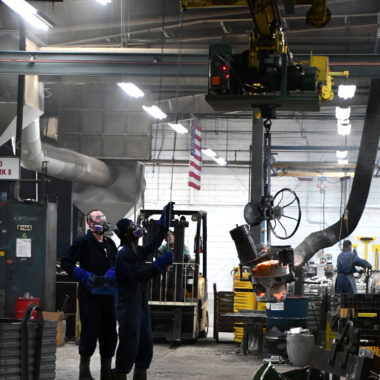Reinvent Your Production with Aluminum Casting Innovations
Reinvent Your Production with Aluminum Casting Innovations
Blog Article
Dive Into the Globe of Aluminum Casting: Recognizing the Various Techniques
Aluminum spreading is a fundamental procedure in the production market, with different approaches employed to create complex and specific elements. Understanding the various methods used in aluminum spreading can provide beneficial insights right into the capabilities and limitations of each strategy. From the typical sand casting technique to the advanced die spreading process, each technique provides distinct advantages depending on the needs of the job. Checking out these varied approaches can offer an extensive sight of the possibilities within the world of light weight aluminum spreading and just how each technique adds to forming the modern manufacturing landscape.
Sand Spreading Approach
Sand casting, a widely-used approach in aluminum spreading processes, entails creating molds made of compacted sand for pouring liquified metal. As soon as the mold and mildew is prepared, it is firmly placed in a flask and molten aluminum is put into the tooth cavity.
After the metal has cooled down and strengthened, the sand mold is escaped to expose the light weight aluminum spreading. Sand casting enables the production of complex forms and huge components that may be hard or expensive to create utilizing other approaches. It is also a lasting strategy as the sand can be reused and used multiple times, decreasing waste in the spreading procedure.
Irreversible Mold Method

One substantial benefit of the Irreversible Mold And Mildew Method is the enhanced dimensional precision it offers. The metal mold and mildew allows for tighter resistances and better information in the final light weight aluminum castings contrasted to sand casting methods. This precision makes it a favored choice for applications where tight dimensional control is critical, such as in the automobile and aerospace markets.

Die Casting Process

Financial Investment Casting Technique
Making use of an accuracy spreading technique, Investment Casting Technique includes producing complex light weight aluminum elements by putting liquified metal into a ceramic mold and mildew. This procedure, also known as lost-wax spreading, begins with the development of a wax pattern of the preferred part (aluminum casting).
The next action entails putting the molten aluminum right into the ceramic mold. The light weight aluminum fills the tooth cavity left by the wax pattern, taking its form exactly. This technique is preferred for its capability to generate complicated forms with high accuracy and a smooth surface area coating. Financial investment spreading is frequently used for manufacturing elements in sectors where complex styles and tight resistances are needed, such as aerospace, auto, and medical devices. The versatility and accuracy of the Investment Casting Strategy make it a useful technique on the planet of aluminum spreading.
Lost Foam Spreading Method
Having checked out the complex precision of Investment Casting Approach, the emphasis currently changes to the innovative technique of Lost Foam Spreading in light weight aluminum part production. Lost Foam Spreading, additionally recognized as evaporative pattern casting, is a modern technique where a foam pattern of the wanted part is created and then coated with a refractory product.
Furthermore, Lost Foam Casting is an economical procedure as it reduces the need for cores and permits for the manufacturing of light-weight components. Despite its benefits, Lost Foam Casting calls for cautious control of the casting process to ensure and avoid problems quality parts.
Final Thought
To conclude, light weight aluminum casting supplies a selection of approaches such as sand spreading, irreversible mold and mildew strategy, die spreading, financial investment casting, and shed foam spreading. Each approach has its very own benefits and applications, making aluminum casting a versatile and extensively made use of process in different industries. Understanding the differences between these methods is essential in selecting the most view website ideal casting method for certain production needs.
Sand spreading, a widely-used method in aluminum spreading processes, involves developing mold and mildews made of compacted sand for pouring liquified steel. aluminum casting.The Irreversible Mold Strategy, like sand spreading, is an additional widespread approach utilized in light weight aluminum casting procedures, supplying distinct benefits in terms of mold reusability and dimensional precision. The metal mold and mildew allows for tighter tolerances and finer information in the final light weight aluminum castings contrasted to sand spreading techniques. The 2 main types of die casting are cold chamber die casting and hot chamber pass away spreading, each ideal for various types of aluminum alloys.In verdict, light weight aluminum casting offers explanation a range of methods such as sand casting, irreversible mold and mildew strategy, pass away casting, investment spreading, and lost foam casting
Report this page